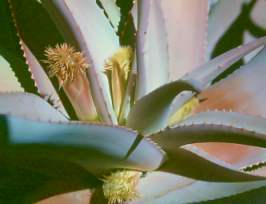Aloe comosa
Aloe comosa Marloth & A.Berger
Family: Asphodelaceae
Common names: Clanwilliam aloe
Introduction
Aloe comosa is a striking, single-stemmed, summer-flowering aloe that is hardly known in cultivation.

Description
Description
Aloe comosa is a single-stemmed aloe that under favourable conditions can reach a height of 2 m; when in flower, the total height may be more than 5 m - the actual flowering spike can attain heights of 3 m or more!
The leaves are blue-green, smooth and slightly recurved (bent backwards). The margins of the leaves have small red brown thorns. The inflorescence, is branched-normally not more than three flower spikes can be seen emerging from the crown. The flower spikes are erect in growth form. Flower colour ranges from rosy-cream to ivory-pink. In most cases the flower spikes are bicoloured: pale at the bottom of the spike with a darker pink hue on the upper parts.

What makes this particularly aloe interesting is the fact that it flowers during the hottest and driest part of the year-November and December.
Distribution and habitat
Distribution description
Aloe comosa has a very small distribution in the winter rainfall area of South Africa. It occurs only in a small section of the northwestern part of the Western Cape: just north of the town of Clanwilliam and in sheltered kloofs bordering on the Ceres Karoo. It is used to extreme heat (above 40°C), but it can survive in mild winter temperatures (-1°C).
Derivation of name and historical aspects
History
Aloe comosa was discovered in the Olifants River Valley in 1905. It is unclear who actually discovered the plant and brought it to the attention of the botanical world. The word comosa means bearing tufts of leaves.
Aloe comosa is classified as rare in its natural habitat. The reasons for this are mainly due to habitat destruction through unsound agricultural practices, limited distribution and illegal plant collecting by over-zealous collectors.
Ecology
Ecology
Pollination is done mainly by bees. It is possible that some evening moths could pollinate this species.
Uses
Use
None are really known, however this is a stunning plant to have in your aloe or water-wise garden.

Growing Aloe comosa
Grow
This is done exclusively from seed. It is possible to root the plant from a truncheon cutting. It is advisable to let the plant dry out for a few weeks - this reduces the sap levels and ensures easy rooting. The severed end can be dusted with flowers of sulphur to prevent fungal spores rotting the plant at a later stage.
Seeds are produced in late February and early March of each year (southern hemisphere). The seed capsules tend to go a pale green and start to split when they are ready for harvesting. The flat, brown seeds are surrounded by a thin, transparent membrane which assists with wind dispersal. The seeds are blown some distance from the parent plant and usually germinate under the protection of a nurse plant.
To grow in a seed tray, use sandy loam with a small amount of very well-rotted, sieved compost. The seeds should be sown not deeper than 0.5 cm. Do not crowd too many seeds into a seed pan, this can lead to damping off when they start germinating. The sowing medium must be well drained. Do not over-water: too much water at a time when the seeds are germinating will ROT them. Water four times a week under warm conditions of 28°C or above. During the winter months only water once every two weeks. Move to a sunny location for the initial germination, especially during the cold winter months.
Sow the seeds in April or May (southern hemisphere). By April of the following year the plants should be strong enough to be planted in a small, plastic, 9 cm pot. Use a well-drained potting medium.
Aloe comosa once established will grow quickly. These plants respond well to feeding with organic products. Please bear in mind when planting these plants out in the garden to give them enough space to develop fully.
References
- Reynolds, G.W. 1950. The aloes of South Africa. Cape Times, Parow, Cape Town.
- Smith, G.F. & Van Wyk, B-E. 1996. Guide to aloes of South Africa. Briza Publications, Pretoria.
Credits
Ian Oliver
Karoo Desert National Botanical Gardens
July 2006
Plant Attributes:
Plant Type: Succulent
SA Distribution: Western Cape
Soil type: Sandy, Loam
Flowering season: Early Summer
PH: Acid, Neutral
Flower colour: Cream
Aspect: Full Sun
Gardening skill: Easy
Special Features:
Horticultural zones









Rate this article
Article well written and informative
Rate this plant
Is this an interesting plant?
Login to add your Comment
Back to topNot registered yet? Click here to register.